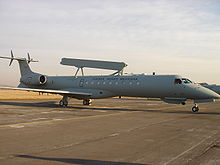Erieye

An Embraer R-99A of the Mexican Air Force with Erieye radar mounted on the fuselage
|
|
| Country of origin |
|
|---|---|
| Introduced | 1996 |
| Type | Multi-mode active electronically scanned array (AESA) pulse-Doppler radar |
| Frequency | S band |
| Range | 450 km |
| Altitude | > 20 km (> 65,000 ft) |
| Azimuth | 150° to each side |
The Erieye radar system, is an Airborne Early Warning and Control System (AEW&C) developed by Saab Electronic Defence Systems (formerly Ericsson Microwave Systems) of Sweden. It uses active electronically scanned array (AESA) technology. The Erieye is used on a variety of aircraft platforms, such as the Saab 340 and Embraer E-99. It has recently been implemented on the Bombardier Global 6000 aircraft.
The Erieye Ground Interface Segment (EGIS; not to be confused with the Aegis combat system) is a major component of the software used by the Erieye system.
The radar provides 300 degree coverage and has an instrumental range of 450 km and detection range of 350 km in a dense hostile electronic warfare environment—in heavy radar clutter and at low target altitudes. In addition to this, the radar is also capable of identifying friends or foes, and has a sea surveillance mode.
The Erieye system has full interoperability with NATO air defence command and control systems.
In 1985 Ericsson Microwave Systems were contracted by the Swedish Defence Material Administration to develop what would become the PS-890 Erieye AEW radar. In the same year a dummy dual-sided phased array antenna was tested on a twin-engined Fairchild Metro aircraft. In 1987 the Metro aircraft was fitted with the radar system for flight trials. Production of the radar started in 1993 following an order for six radars for the Swedish Air Force for fitment in Saab 340 aircraft. The first two production radars were delivered in 1996.
The Erieye AEW&C mission system radar is an active, phased-array, pulse-doppler sensor that can feed an onboard operator architecture or downlink data (via an associated datalink subsystem) to a ground-based air defence network. The system employs a large aperture, dual-sided antenna array housed in a dorsal 'plank' fairing. The antenna is fixed, and the beam is electronically scanned, which provides for improved detection and significantly enhanced tracking performance compared with radar-dome antenna systems. Erieye detects and tracks air and sea targets out to the horizon, and sometimes beyond this due to anomalous propagation — instrumented range has been measured at 450 kilometres (280 mi). Typical detection range against fighter-sized targets is approximately 425 kilometres (264 mi), in a 150° broadside sector, both sides of the aircraft. Outside these sectors, performance is reduced in forward and aft directions.
...
Wikipedia
